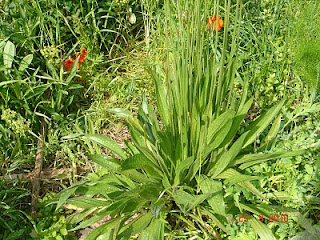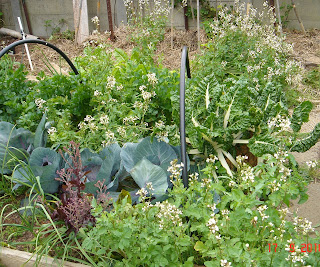Have you ever wondered how you would survive if you couldn't get to any shops or if supplies ran out and there was no food available? In the area where I live there is very little to be had by the way of edible plants in the surrounding countryside. Most of it is in the form of vineyards and wheatfields. There's also very little to eat in areas where indigenous bush is, apart from guinea fowl and francolins.
If I have to play "survivor" in my garden, number one priority would be laying hens. With a few eggs and some greens you can prepare a very nice meal. I make the most of the greens in the garden that seem to thrive during the cold of winter, before the summer veg is available. Rocket and nasturtium leaves are so abundant that I don't need to buy lettuce. They are packed with vitamins and minerals and have very good antibiotic properties too.
I think the leafy greens make up for the lack of fruit in winter. I do have a lemon tree and now a kumquat tree which bears fruit, but the other citrus tree bears a very sour little orange, which is only good for marmalade.
Greens are not very filling, so it's important to have a good lot of root vegetables. What can be easier than potatoes and sweet potatoes? Another very generous root vegetable is the Jerusalem artichoke. The yellow flowers are so beautiful and striking. The leaves have slight antibiotic properties and the bulbs are very abundant.
Red cabbage does well in my garden. It's hardy and less prone to disease than white cabbage. It makes a good staple for cooked or raw meals. I make a nice meal with cabbage and mixed greens from the garden with linguini.
Quite a few weeds are perfectly edible, often having a slight bitter flavour. It's worthwhile getting a book on weeds to identify edible ones. I tend to have a nibble to see whether they are tasty or not. So far I've survived!
The bitter flavour of dandelion and chicory leaves is very healthy for the liver and adds a nice flavour to a meal as long as it's not overpowering. We westeners tend to be real sissies when it comes to bitter flavours, which is very sad because bitters are so good for health. I reckon if we were starving taste would not be so important!
It seems to me it's a real luxury to have just an ornamental garden, and I like things to self seed in amongst ornamental plants because self-seeded plants always seem so healthy and happy. I had cherry tomatoes in between shrubs of all types last year, and they produced loads of tomatoes without any disease.






